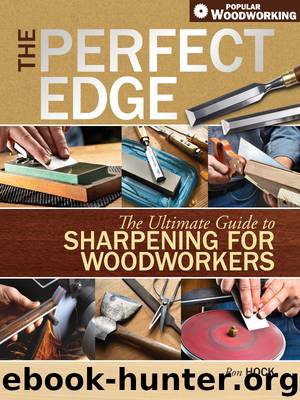The Perfect Edge by Ron Hock

Author:Ron Hock [Hock, Ron]
Language: eng
Format: epub
Tags: ebook, book
Publisher: F+W Media, Inc.
Published: 2011-05-29T05:00:00+00:00
A star-wheel dresser crushes the surface to true and dress the grinding wheel.
A diamond scrapes the high spots off to achieve the same result.
A close-up of both dressing tools. Wear a respirator – both jobs are very gritty.
This simple system from Oneway Manufactiuring will take the shakes out of your grinder.
I never used to like bench grinders much. I used one frequently when I first started out making knives in the 1980s. I found it to be gritty and bouncy – no matter how much I dressed them, the wheels never seemed round. I switched to belt grinders exclusively until quite recently, when I discovered that by simply balancing the wheel, the bouncy problem could be solved. Oneway Manufacturing (www.oneway.ca), the ones who make the wood lathes and the Wolverine grinding jig for turning tools, makes the Wolverine Precision Balancing System. Now my bench grinder runs smoothly for the first time. The system replaces the flanges that hold the wheel to the grinder. The Oneway flanges have a concentric raceway that allows you to move weights around while the wheel is on a bearing stand, not unlike balancing a car’s wheel and tire. You slide the weights in the raceway until the wheel stays put at any position and it’s balanced. This takes a few minutes of patient fussing but the results are worth it: smoother, quieter grinding and a better surface finish on the tool. Plus, the wheel will last longer because you’re not dressing it as often. My grinder still makes a gritty mess but it finally runs smoothly and I’m much more inclined to use it.
BELT SANDERS
Bench-mounted belt sanders (in the metalworking world we call them belt grinders) can perform a number of sharpening chores. They run cooler than bench-grinder wheels (you still must be careful, though,) and can switch among many grits in seconds. Because you need only swap belts when they get dull, there is no wheel truing and dressing as there is with bench grinders, so there’s less dust in the shop. Belts are available in a variety of abrasives and grit sizes. We use the basic aluminum oxide metalworking belts. However, I also recommend that you try out some of the newer aluminum-zirconia belts and 3M’s Trizac belts that cut quickly and come in very fine grit sizes for real polishing. There seem to be new belt innovations hitting the marketplace all the time, so it might be wise to shop around and try out the latest offerings.
The small, inexpensive, 1" × 30" belt grinder models are very handy and take up little space. The table that comes with them may not adjust enough for the acute angles we so often need, but it’s a simple matter to cut a wooden wedge to give the table a more effective angle at the belt.
Download
This site does not store any files on its server. We only index and link to content provided by other sites. Please contact the content providers to delete copyright contents if any and email us, we'll remove relevant links or contents immediately.
Audition by Ryu Murakami(4099)
The Body: A Guide for Occupants by Bill Bryson(3802)
Adulting by Kelly Williams Brown(3671)
Housekeeping by Marilynne Robinson(3402)
Zero Waste Home by Bea Johnson(3292)
Be in a Treehouse by Pete Nelson(3213)
Seriously... I'm Kidding by Ellen DeGeneres(3100)
Better Homes and Gardens New Cookbook by Better Homes & Gardens(2954)
Barkskins by Annie Proulx(2880)
The Healing Self by Deepak Chopra(2796)
Hedgerow by John Wright(2777)
The Life-Changing Magic Of Tidying Up- The Japanese Art Of Decluttering And Organizing (v5.0) by Marie Kondo(2745)
Spark Joy by Marie Kondo(2677)
The Genius of Japanese Carpentry by Azby Brown(2609)
The Cellar by Natasha Preston(2595)
Work Clean by Dan Charnas(2562)
120 Days of Sodom by Marquis de Sade(2439)
A Monk's Guide to a Clean House and Mind by Shoukei Matsumoto(2405)
The Book of Numbers by Peter Bentley(2404)
